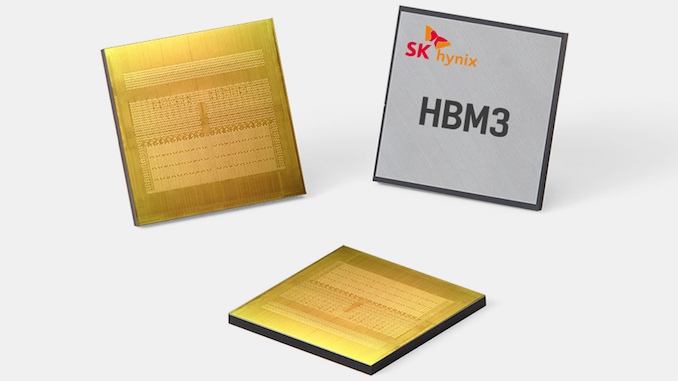SK Hynix was one of the key developers of the original HBM memory back in 2014, and the company certainly hopes to stay ahead of the industry with this premium type of DRAM. On Tuesday, buried in a note about qualifying the company's 1bnm fab process, the the manufacturer remarked for the first time that it is working on next-generation HBM3E memory, which will enable speeds of up to 8 Gbps/pin and will be available in 2024.
Contemporary HBM3 memory from SK Hynix and other vendors supports data transfer rates up to 6.4Gbps/pin, so HBM3E with an 8 Gbpis/pin transfer rate will provide a moderate, 25% bandwidth advantage over existing memory devices.
To put this in context, with a single HBM stack using a 1024-bit wide memory bus, this would give a known good stack die (KGSD) of HBM3E around 1 TB/sec of bandwidth, up from 819.2 GB/sec in case of HBM3 today. Which, with modern HPC-class processors employing half a dozen stacks (or more), would work out to several TB/sec of bandwidth for those high-end processors.
According to the company's note, SK Hynix intends to start sampling its HBM3E memory in the coming month, and initiate volume production in 2024. The memory maker did not reveal much in the way of details about HBM3E (in fact, this is the first public mention of its specifications at all), so we do not know whether these devices will be drop-in compatible with existing HBM3 controllers and physical interfaces.
| HBM Memory Comparison | ||||||
| HBM3E | HBM3 | HBM2E | HBM2 | |||
| Max Capacity | ? | 24 GB | 16 GB | 8 GB | ||
| Max Bandwidth Per Pin | 8 Gb/s | 6.4 Gb/s | 3.6 Gb/s | 2.0 Gb/s | ||
| Number of DRAM ICs per Stack | ? | 12 | 8 | 8 | ||
| Effective Bus Width | 1024-bit | |||||
| Voltage | ? | ? | 1.2 V | 1.2 V | ||
| Bandwidth per Stack | 1 TB/s | 819.2 GB/s | 460.8 GB/s | 256 GB/s | ||
Assuming SK hynix's HBM3E development goes according to plan, the company should have little trouble lining up customers for even faster memory. Especially with demand for GPUs going through the roof for use in building AI training and inference systems, NVIDIA and other processor vendors are more than willing to pay premium for advanced memory they need to produce ever faster processors during this boom period in the industry.
SK Hynix will be producing HBM3E memory using its 1b nanometer fabrication technology (5th Generation 10nm-class node), which is currently being used to make DDR5-6400 memory chips that are set to be validated for Intel’s next generation Xeon Scalable platform. In addition, the manufacturing technology will be used to make LPDDR5T memory chips that will combine high performance with low power consumption.
from AnandTech https://ift.tt/Wm8Oqo0
via IFTTT

0 comments:
Post a Comment